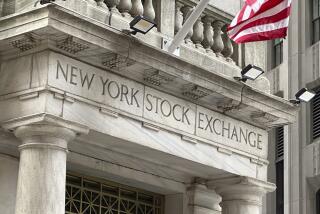3 Familiar Old-Timers Are Bumped Off the Dow
- Share via
NEW YORK — The Dow has hung up on Ma Bell.
Acknowledging changes in the U.S. economy and the stock market, Dow Jones & Co. said Thursday that it would replace AT&T; Corp. and two other longtime members of its blue-chip industrial average with three much bigger and faster-growing firms.
AT&T;, Eastman Kodak Co. and International Paper Co. will give way to insurer American International Group Inc., drug giant Pfizer Inc., and Baby Bell Verizon Communications Inc. in the 30-stock index beginning April 8, Dow Jones said.
The move -- the first reshuffling of the nation’s best-known market barometer since Nov. 1, 1999 -- “is a recognition of the growth of finance and healthcare” in the economy, said John Prestbo, editor of Dow Jones Indexes. He assists Paul E. Steiger, managing editor of the Dow Jones-owned Wall Street Journal, in overseeing the 107-year-old stock index.
The newcomers dwarf the companies they are replacing in market capitalization, or total value of their outstanding shares. Those figures, as of Thursday, were for Pfizer, $271.4 billion; AIG, $191.3 billion; Verizon, $102.2 billion; International Paper, $20.5 billion; AT&T;, $15.3 billion; and Kodak, $7.2 billion.
The three ousted firms are the smallest in the index in terms of market cap. The calculation of the Dow is revised on days that changes are made so that the index’s value isn’t instantly altered.
Ma Bell is being supplanted by one of her offspring: Verizon is the successor firm to one of the seven regional phone companies created by the court-ordered breakup of AT&T; in 1984. SBC Communications Inc., another Baby Bell, joined the Dow in 1999.
AT&T; has been in the index since 1939, when it replaced IBM Corp. (IBM wasn’t added back to the Dow until 1979.) Kodak has been in the index since 1930 and International Paper since 1956.
Being a Dow component enhances a company’s prestige and visibility -- and being dropped can sting a firm’s pride.
AT&T;, in a statement, said the company remained “one of the world’s leading communications companies” and “a bellwether of the U.S. economy.”
At Kodak, a spokesman told Associated Press that “membership in any index has no bearing on our ability to manage the company for profitable growth.”
Pfizer’s selection “appropriately reflects the importance of this sector to investors, patients and the global healthcare community,” Pfizer Chairman Hank McKinnell said in a statement.
Kodak shares sank $1.07 to $25.10 on Thursday, AT&T; fell 27 cents to $15.31, and International Paper eased 8 cents to $20.49, all on the New York Stock Exchange. Also in Big Board trading, AIG jumped $1.97 to $73.32, Pfizer rose 54 cents to $35.59, and Verizon gained 36 cents to $36.90.
Prestbo, in an interview, called the Dow “a subjective index” that attempts to reflect the changing character of the stock market and the economy as a whole. But to keep continuity, he said, “the idea is not to change the Dow very often.”
There is no “watch list” of stocks on the way out or on the way in, Prestbo said. Instead, he and Steiger sit down sometimes as infrequently as once a year to discuss the makeup of the index.
Charles H. Dow created the Dow in 1896. There were 12 stocks in the first index. It was expanded to 30 in 1928.
Critics sometimes brand the Dow as stodgy, but with the latest move, Dow Jones has replaced 14 of the 30 stocks since 1991, adding more service and technology issues to the mix.
At the last reshuffling, in 1999, Sears Roebuck & Co., Union Carbide Corp., then-Chevron Corp. and Goodyear Tire & Rubber Co. were shown the door in favor of SBC Communications, Home Depot Inc., Intel Corp. and Microsoft Corp. The latter two were the first Nasdaq-traded stocks in the Dow’s history.
“We continue to be a services and healthcare economy,” and the Dow reflects that, said Charles B. Carlson, an editor at Dow Theory Forecasts, a Hammond, Ind.-based investment newsletter.
With the elimination of International Paper, he noted, basic-materials stocks will drop to 5% of the Dow’s weighting. Even so, industrial and materials stocks still represent 30% of the index’s weighting, Carlson said.
Despite its name, the modern Dow has never been a purely “industrial” index. In 1928, it included theater chain Paramount Publix and retailer Woolworth.
Carlson praised Dow Jones for moving carefully with index changes, noting that during the tech-stock boom of the late 1990s it was under great pressure to include some Internet highfliers that have since crashed.
*
(BEGIN TEXT OF INFOBOX)
Dow makeover
With the changes announced Thursday, Dow Jones & Co. has replaced almost half of the 30 stocks in the Dow Jones industrial average since 1991. Substitutions since then:
*--* Year In Out 1991: Caterpillar Navistar International J.P. Morgan Primerica Walt Disney USX (U.S. Steel) 1997: Hewlett-Packard Texaco Johnson & Johnson Bethlehem Steel Travelers Group Westinghouse Electric Wal-Mart Stores Woolworth 1999: Home Depot Sears Roebuck Intel Goodyear Tire Microsoft Chevron SBC Communications Union Carbide Thursday: American Intl. Group AT&T; Pfizer Eastman Kodak Verizon Communications International Paper
*--*
Source: Reuters
*
(Begin Text of Infobox)
The original Dow 30
The Dow Jones industrial average, created by Dow Jones & Co. co-founder Charles H. Dow, first appeared on May 26, 1896, and initially contained 12 stocks. The index was expanded to 30 stocks Oct. 1, 1928. The number has remained constant since then, although most of the original stocks have been replaced over the years. The original Dow 30:
Allied Chemical
American Can
American Smelting
American Sugar
American Tobacco
Atlantic Refining
Bethlehem Steel
Chrysler
General Electric
General Motors
General Railway Signal
Goodrich
International Harvester
International Nickel
Mack Truck
Nash Motors
North American
Paramount Publix
Postum (General Foods)
Radio Corp. of America
Sears Roebuck
Standard Oil of New Jersey
Texas Corp.
Texas Gulf Sulphur
Union Carbide
U.S. Steel
Victor Talking Machine
Westinghouse Electric
Woolworth
Wright Aeronautical
*
Source: Dow Jones & Co.
More to Read
Inside the business of entertainment
The Wide Shot brings you news, analysis and insights on everything from streaming wars to production — and what it all means for the future.
You may occasionally receive promotional content from the Los Angeles Times.









